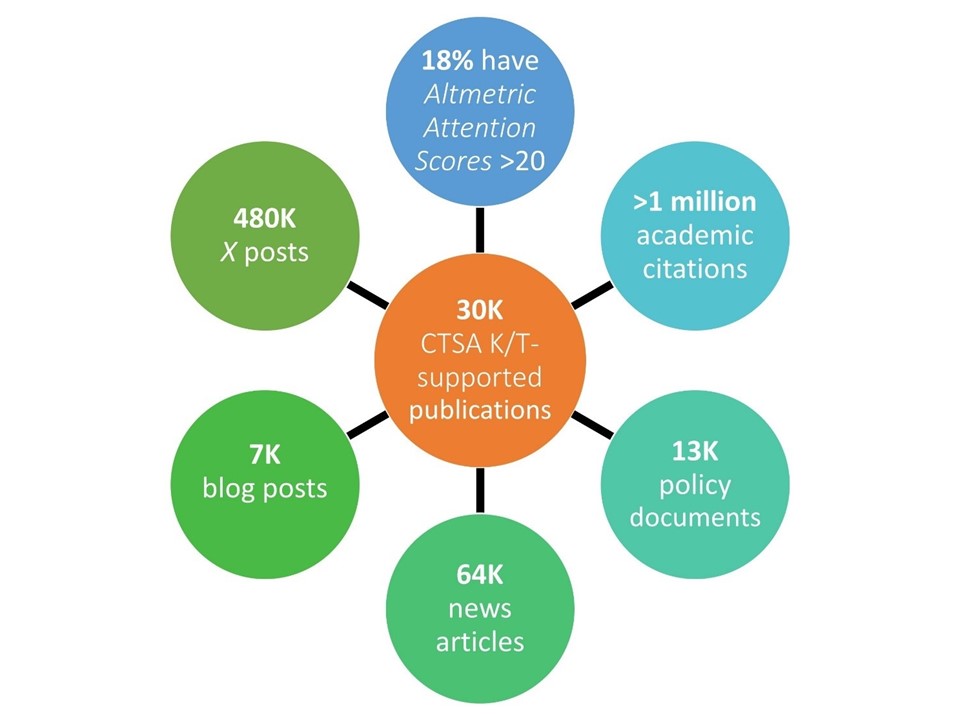CTSA Scholars and Trainees Expand the Reach of Translational Science

In a new study published in the Journal of Clinical and Translational Science, lead author Eric Nehl, PhD, Director, Georgia CTSA Evaluation and Continuous Improvement, Emory University, collaborated with colleagues across multiple CTSA hubs to evaluate the public reach of research produced by KL2 scholars and TL1 trainees across the nation. The publication, Academic Influencers: Clinical and Translational Science Scholars and Trainees at the Intersection of Influential Scholarship and Public Attention, provides new insights into how early-career scientists are contributing to broader public health and policy conversations.
“This manuscript highlights not only the high caliber of CTSA K scholars and T trainees, but also the comprehensive nature of CTSA training programs that results in medical research of special interest to health care providers and policymakers as well as engaging the general public and promoting trust in science. These scholars and trainees are the future backbone of a 21st century medical research workforce,” says Michael G. Kurilla, MD-PhD, Director, Division of Clinical Innovation, National Center for Advancing Translational Sciences (NCATS).
CTSA-supported scholars and trainees are increasingly contributing to public discourse and influencing decision-making beyond traditional academic channels. They demonstrate the evolving role of translational scientists not only as generators of knowledge, but also as communicators, connectors, and catalysts for change.
The team analyzed over 30,000 publications produced by KL2 and TL1 scholars from 2006 through 2024. Using Altmetric Explorer, they assessed the extent to which these publications were referenced in public forums, including news outlets, blogs, social media platforms, and policy documents, in addition to over one million academic citations. Their analysis found that nearly one in five publications (18.5%) had Altmetric Attention Scores of 20 or more, marking them as high-impact in the public sphere. Collectively, these papers were referenced in approximately 64,000 news articles, 480,000 social media posts, and over 13,000 policy documents. Publications that were cited more frequently in academic literature, published in higher-impact journals, or already referenced in policy were more likely to achieve broader public attention.
“Our findings show a strong and growing public interest in science, underscoring the need to make research more visible beyond academic circles. It’s increasingly important to train clinical and translational scientists to not only publish in scholarly journals, but to communicate their work clearly and effectively to the public and decision makers so their research can drive real-world impact,” explains Dr. Nehl.
These findings underscore how collaborative efforts across the CTSA consortium are strengthening the national capacity to measure and accelerate translational science. This paper sets a precedent for how training program outcomes can be evaluated using innovative bibliometric tools. It also signals a shift in how success in translational science is defined by placing greater value on the dissemination of research into public and policy arenas. “Researchers can use the methods we’ve demonstrated here to understand how other NIH-supported programs accelerate translation across different areas of public health interest,” adds co-author Nikki Llewellyn, PhD, Associate Director, Georgia CTSA Evaluation and Continuous Improvement, Emory University.
The study’s cross-hub collaboration included evaluation experts from Emory University, Case Western Reserve University, the University of North Carolina at Chapel Hill, and Virginia Commonwealth University, highlighting the importance of collaborative scholarship in demonstrating translational impact. As the field of evaluation science continues to grow, partnerships across CTSA hubs are proving to be valuable and essential for innovation.
“Georgia CTSA’s evaluation leaders have unparalleled expertise in analyzing large publication datasets to determine translational impact. Working together on this study revealed a new aspect of evaluating academic influence on the public that will benefit all going forward,” says co-author Clara Pelfrey, PhD, Evaluation Director, Case Western Reserve University.